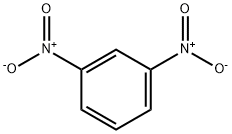M-디니트로벤젠 C화학적 특성, 용도, 생산
개요
1,3-Dinitrobenzene (1,3-DNB) is an impurity present in the
manufacture of 2,4,6-trinitrotoluene. Workers in munitions
plants are at risk of exposure. While it does not bioaccumulate, it
persists in the environments (air, water, and soil) with slow rates
of degradation. Metabolism in animals (rabbits) results in
reduction of the nitro functionalities to amine functionalities to
produce 2,4-diaminophenol, m-nitroaniline, m-phenylenediamine,
and 2-amino-4-nitrophenol. Human exposure is generally
dermal contact or inhalation of vapor.
화학적 성질
orange to yellow crystalline powder. Freely soluble in benzene, chloroform, ethyl acetate, soluble in alcohol, slightly soluble in water. Can evaporate with water vapour.
용도
1,3-Dinitrobenzene (1,3-DNB) is an impurity present in the manufacture of 2,4,6-trinitrotoluene. Dinitrobenzene (as a mixture of 1,2-dinitro- 1,3-dinitro- and 1,4-dinitro-isomers) is used in the manufacture of dyes and explosives, and in organic syntheses.
제조 방법
1,3-Dinitrobenzene is accessible by nitration of nitrobenzene. The reaction proceeds under acid catalysis using sulfuric acid. The directing effect of the nitro group of nitrobenzene leads to 93% of the product resulting from nitration at the meta-position. The ortho- and para-products occur in only 6% and 1%, respectively.
정의
ChEBI: 1,3-dinitrobenzene is a dinitrobenzene that is benzene disubstituted at positions 1 and 3 with nitro groups. It has a role as a neurotoxin.
일반 설명
1,3-Dinitrobenzene is a yellow solid with a slight odor. Sinks in water. (USCG, 1999)
공기와 물의 반응
Slowly mixes with water.
반응 프로필
All three isomers have similar properties and may react vigorously with oxidizing materials. Their reaction with nitric acid (nitration) will lead to a mixture of trinitrobenzenes possessing high-explosive properties [Urbanski, 1967, vol. 3, p. 290]. If heat and reaction conditions of the nitration are not controlled, detonation comparable to TNT may occur [Anon., J. R. Inst. Chem., 1960, 84, p. 451]. Mixture of 1,3-dinitrobenzene with tetranitromethane was found highly explosive [Urbanski, 1964, vol. 1, 592]. 1,2-dinitrobenzene is a severe explosion hazard when shocked or exposed to heat or flame. When heated to decomposition all dinitrobenzens emit toxic fumes of nitrogen oxides [Sax, 9th ed., 1996, p. 1374].
건강위험
Inhalation or ingestion causes loss of color, nausea, headache, dizziness, drowsiness, and collapse. Eyes are irritated by liquid. Stains skin yellow; if contact is prolonged, can be absorbed into blood and cause same symptoms as for inhalation.
화재위험
Behavior in Fire: May explode
Safety Profile
Suspected carcinogen.
Human poison by ingestion. Experimental
poison by ingestion, intraperitoneal, and
intravenous routes. Human systemic effects
by skin contact: cyanosis and motor activity
changes. Experimental reproductive effects.
An eye irritant. Mutation data reported.
Mixture with nitric acid is a high explosive.
Mixture with tetranitromethane is a hgh
explosive very sensitive to sparks. When
heated to decomposition it emits toxic
fumes of NOx. See also 0and pDINITROBENZENE.
환경귀착
Biological. Under anaerobic and aerobic conditions using a sewage inoculum, 1,3-
dinitrobenzene degraded to nitroaniline (Hallas and Alexander, 1983). In activated sludge
inoculum, following a 20-d adaptation period, no degradation was observed (Pitter, 1976).
Photolytic. Low et al. (1991) reported that the nitro-containing compounds (e.g., 2,4-
dinitrophenol) undergo degradation by UV light in the presence of titanium dioxide yielding
ammonium, carbonate, and nitrate ions. By analogy, 1,3-dinitrobenzene should degrade forming
identical ions.
Chemical/Physical. Releases toxic nitrogen oxides when heated to decomposition (Sax and
Lewis, 1987). 1,3-Dinitrobenzene will not hydrolyze in water (Kollig, 1993).
Purification Methods
Crystallise 1,3-dinitrobenzene from alkaline EtOH solution (20g in 750mL 95% EtOH at 40o, plus 100mL of 2M NaOH) by cooling and adding 2.5L of H2O. The precipitate, after filtering off, is washed with H2O, sucked dry, and crystallised from 120mL, then 80mL of absolute EtOH [Callow et al. Biochem J 32 1312 1938]. Alternatively crystallise it from MeOH, CCl4 or EtOAc. It can be sublimed in a vacuum. [Tanner J Org Chem 52 2142 1987, Beilstein 5 IV 739.]
M-디니트로벤젠 준비 용품 및 원자재
원자재
준비 용품









